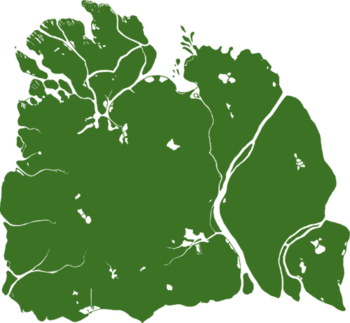Woodstead
This article is incomplete because it is pending further input from participants, or it is a work-in-progress by one author. Please comment on this article's talk page to share your input, comments and questions. Note: To contribute to this article, you may need to seek help from the author(s) of this page. |
Woodsteasian Federation Federasjonet Woduland | |
|---|---|
| Motto: Through strife or victory, with compassion and unity." | |
 | |
| Capital and largest city | Woldland |
| Official languages | English, Wudu |
| Demonym(s) | Woodsteasian |
| Government | |
| Legislature | Federal Parliament |
| Establishment | |
• Settlement of Noviomagus | c.230 AD |
• Union of Wodested | 1193 |
| 1713 | |
• Independent Republic | 2013 |
• Federation | 1 September 2015 |
| Area | |
• Total | 1,605,487 km2 (619,882 sq mi) |
• Water (%) | 9.96% |
| Population | |
• 2015 estimate | 123,721,747 |
• Density | 76.2/km2 (197.4/sq mi) (77.1) |
| Gini (2014) | 0.24 low |
| HDI (2012) | 0.87 very high |
| Currency | Woodsteasian Marc (Mc) (WSC) |
| Time zone | Astyrian Standard Time (UTC±0) |
| Date format | dd/mm/yyyy |
| Driving side | right |
| Calling code | +555 |
| ISO 3166 code | WS |
| Internet TLD | .wd |
Woodstead, officially the Woodsteasian Federation, is a sovereign state in northern Astyria. It is an island nation lying to the north of Nikolia on the Teudallum continental shelf having a total landmass of 558,166 square miles (1,445,640 km2) spread over 30 islands. Woodstead is a federal republic with a parliament and its government is headed by a directorial government. The capital city and largest city by population and size is Woldland.
Woodstead still retains a claim over the Commonwealth of Kenega, though only oversees defense from EUF Faronham. The island of Libetta, until 2015, was an overseas territory of Woodstead, but has been reincorporated as a province after the federalisation of the Woodsteasian Isles.
Woodstead is a developed nation, with a high HDI. Following the dissolution of the Erlenic Empire, Woodstead has been increasingly active in regional trade as a major independent Astyrian hub.
Etymology
The name Woodstead derives from the Middle English Wodested, from wode ("wood") + sted ("place").
History
Antiquity
In which the first people arrived on Woodstead.
Middle ages
In which more people arrived and things happened.
Woodsteasian Federation
In 2012, the Erlenic Empire was dissolved and in its place the Woodsteasian Federation was formed as a federated republic.
Geography
The Woodsteasian Isles are made up of 3 main islands and numerous other smaller ones. The main island is Provincial Island, also known as Parva. Ey is the second-largest island located to the east of Provincial, which is followed further to the east by the island of Libetta.
The Ey Channel separates the Ey from Provincial Island, running north to south, almost meeting at the north with the Etta Channel between the Ey and Libetta. Major rivers include the Tyne, Charter, Claudiate, and Annad. There are many small lakes and streams across the Woodsteasian Isles.
Woodstead is dominated by coniferous forest, with scattered areas of mixed forest and grassland mainly to the south.
Government
Woodstead is a federal republic. The Federal Government of Woodstead is led by the Guardian Directorate of eleven members, an executive cabinet, Guardian Directorate which collectively holds a title of head of state and government. The Federal Parliament is the legislative branch, of which many members are Ministers under the Guardian Directorate.
Guardian Directorate
The 11-member Guardian Directorate is the joint head of state and government. The Directorate is elected every 4 years and there are no limitations on terms. The President of the Directorate is an official ceremonial title, but does not have any further privileges than other members. The President is elected by the Directorate every six months with the oversight of the Federal Parliament. The idea of Directorate was conceived by a hybrid of directorial and parliamentary republics. The eleven members each head a Federal Office which each have cabinets of their own Ministers, chosen from members of the Federal Parliament.
Administrative Divisions
As of 1 September 2015 there are 33 Federal Subjects of Woodstead: 22 provinces with counties and independent cities, ten Federal Cities covering a modern agglomeration around major cities each, and Indigenous Congress as another, representing 10 autonomous territories. All 33 subjects were proposed in 2014 prior to the Constitutional Referendum, and operate fully as of 2015. Aside from these subjects is the Woodsteasian territory of Kenega.
Kenega
In 2014, a referendum for the fomer Erlenic territory of Kenega favoured some arrangements to remain as a de jure protectorate of Woodstead. Kenega has retained the Guardian Directorate as a collective head of state. The Kenega Office is an advisory panel formed out of members from the following Federal Offices:
The Prime Minister of Kenega, Kendal Devarnum, is to remain in contact with the Kenega Office on defense and security matters, as Woodstead claims the land. The governments of Kenega and Woodstead jointly maintain the EUF Faronham base in Kenega which hosts joint parades and stages demonstrative exercises between Woodsteasian and Kenegan personnel.
Foreign Relations
As of 2016, Woodstead is no longer a member of the World Assembly or of the Astyrian Treaty Organisation; this is a consequence of the July 2016 Act of Global and Regional Neutrality. However, Woodstead is still integrated in to Astyrian cooperation. As a neutral state, Woodstead is one of a few Astyrian nations to act indecisively on regional imperialistic efforts, such as the infamous attempt of Rombergian Kaiser Johan Lesenov to annex the unoccupied Western Tundra of Lorecia.
Woldland, Oppidum, and Saint Edward are the three cities with a diplomatic presence. With consulates and embassy complexes, these three large cities are home to private military airports and host the bulk of Astyrian networking events throughout the year.
As well as being a part of Astyrian politics, Woodstead has been a major overseer and partner in the transition of Nyasott, Ijarnesyl in to a fully realised state as one founding member of the NDO- a coalition of former Erlenic claims to democratise and prosper with new sovereign governments with de-centralised power. Along with Cez-Zaeri, Woodstead is one of two new nations which have formed out of the coalition, and still preside over the eventual founding of the Nyasutro Federation, scheduled for March 2017.
The Ij26 and the Federal Government of Woodstead are currently in the proposal stages of negotiating a possible trade deal between all nations on the continent of Ijarnesyl, Woodstead, and possibly Cez-Zaeri.
Military and security
Woodstead does not have a standing army owing to the Act of Global and Regional Neutrality. Therefore, law enforcement agencies and emergency services, as of 2017, form a governmental paramilitary collective and security force. Upon approval of Federal Parliament, certain forces of can contribute manpower to help defend the nation to assemble a temporary military. This collective of agencies also consists of the Federal Investigatory Force which works with other nations to share and collect information on possible risks, such as terrorism and natural disasters.
Economy
Woodstead has a mixed economy and an expansive welfare state. In relation to other Astyrian nations, it has a relatively small economy based on regional exchange rates. The Federal Bank is the central bank which oversees the production of currency and regulates inflation rates. The GDP is largely split between a service sector and resurgence in a regulated manufacturing sector.
Renewable energy is the largest single industry in Woodstead. The Federal Government's renewable energy company, Cenergy, holds a 86% share in national electricity production and employs about 900,000 people; Cenergy also issues permits an grants to homes, farms, and small, remote communities to increase local, de-centralised electricity production.
Under the 2015 Act of Poverty Prevention, relative poverty is defined as below 65% of the median household income. As of July 2016, 16% of the population lived below this line. Using this definition, a 2016 audit of the last 10 years shows that this figure has shrunk, and that around half of these people fall above the poverty line within 2 years of first being declared below this line. As of 2015, Woodstead runs an annual Social Mobility Survey- a longitudinal study of how long people remain below the 2015 poverty line in the future.
Demographics
Woodstead conducts a Universal Census every 5 years as of 2015, and an annual sample of Household Surveys. This is managed by the Central Registry, a government agency formed in 2015 by the merger of Libetta Registrar Office and Woodsteasian Statistics. The first Universal Census (2015) estimates that 123,721,747 persons currently live in Woodstead; 30,000 Woodsteasian citizens across Astyria were also issued with the UCPlus to address concerns and demographics of ex-patriates, dual citizens, and short-term workers overseas.
Woodstead has recently experienced a boom in births, with the 2015 birth rate standing at around 4.5 births per 1,000 people. In addition, the 2016 figure for LGBT*QIA+ adults (above 17) identified that 10% of the adult population identify themselves as homosexual, 11% as bisexual and pansexual, 11% as trans*; and 14% as genderqueer, agender, bigender, nonconforming, or non-binary. Same-sex marriages, as of 2011 have become more prevalent as of the Same-Sex Marriage Act of 2010; this trend has slowed down since 2015, and marriages have generally declined since 2001. Cohabitation has since been the prominent trend in couples-especially those with children and dependents.
Ethnic groups
Indigenous Woodsteasians have possibly populated the Isles for many millennia. The first known migration came from Roman Italy (Italia) in around 230; several subsequent waves of widespread migration from Europe followed between the late 12th century and 17th century. Modern-day Woodsteasians are descended from European and indigenous miscegenation, mainly dating back to the early 15th century. A recent study by Woldland School of Social Sciences and Anthropology suggests that 3% of the modern-day population have traceable links back to the first migration, whilst 40% have traceable ancestry dating back to the second major wave miscegenation during the expansion of Erlenica.

